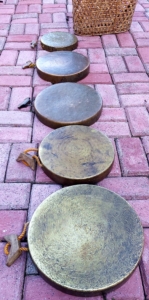The Gangha is a hand-held gong with a yellow rope attached to a handle for comfortable hand-held use and practice of the performer in an ensemble. The artifact is flat and thin rimmed with a hollow inside with unique divots and marks within to produce its unique and distinctive sound.
The Gangha is the main instrument used for Indigenous Filipino dances. Each group within the Cordillera region has a unique tempo and sometimes incorporates different percussion instruments within the music. Traditionally, gangha players are mostly men with women joining them in dance. Modern musicians largely inherit the spirit.
There is no material evidence of large-scale craft workshops related to metal production in the Philippines. The production of gongs is not local to the Philippines, for signs of procedures such as melting metals to make such an instrument are not found from an archaeological standpoint in the Philippines. Similarly, no metalwork specialization evidence such as concentration of raw materials, molds of gangs or wastes deposits are discovered so far. The presence of gangha as an essential component to traditional ritual activities indicates the signs of trade with other regions, such as Indonesia, helping situate the Philippines in the large trading network in Southeast Asia and even Asia as a whole.


